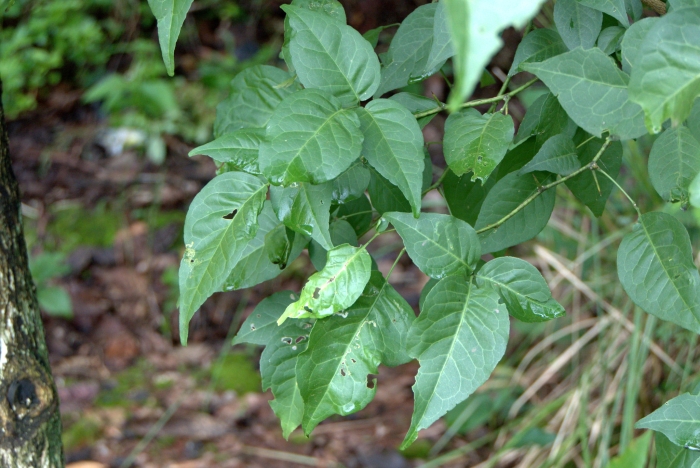Bael
(Aegle marmelos)
Bael (Aegle marmelos)
/
/

© Dinesh Valke
CC BY-SA 4.0
Image By:
© Dinesh Valke
Recorded By:
Copyright:
CC BY-SA 4.0
Copyright Notice:
Photo by: © Dinesh Valke | License Type: CC BY-SA 4.0 | License URL: http://creativecommons.org/licenses/by-sa/4.0/ | Uploader: dineshvalke | Publisher: iNaturalist |

























Estimated Native Range
Summary
Aegle marmelos, commonly known as bael or Bengal quince, is a deciduous tree native to dry deciduous forests, scrub forests, and hillsides of the Indian subcontinent and Southeast Asia. It typically grows up to 43 feet tall with a pale brown, flaky bark and trifoliate aromatic leaves. The tree produces greenish-white, sweetly scented flowers from March to May, followed by large, spherical, hard-shelled fruits that ripen to a yellowish color in December. The fruit pulp is aromatic, resembling marmalade in taste, and is rich in vitamins and minerals.
Bael is valued for its drought tolerance and ability to thrive in a wide range of soil conditions, from sandy to loamy, and can withstand temperatures up to 122°F (50°C). It requires minimal water once established, making it suitable for xeriscaping. In cultivation, bael is often planted for its ornamental foliage, fragrant flowers, and unique fruit, which is consumed fresh, dried, or made into a beverage. The tree is revered in Hinduism and Buddhism, often found in temple gardens, and is used in various traditional rituals. The leaves, bark, roots, and seeds have medicinal properties and are used in Ayurvedic medicine to treat gastrointestinal issues. The wood is durable and used for tool handles, while the gum exuded from the trunk has medicinal uses. Bael can be susceptible to fruit fly infestations, which can damage the fruit crop. It is not considered invasive outside its native range.CC BY-SA 4.0
Bael is valued for its drought tolerance and ability to thrive in a wide range of soil conditions, from sandy to loamy, and can withstand temperatures up to 122°F (50°C). It requires minimal water once established, making it suitable for xeriscaping. In cultivation, bael is often planted for its ornamental foliage, fragrant flowers, and unique fruit, which is consumed fresh, dried, or made into a beverage. The tree is revered in Hinduism and Buddhism, often found in temple gardens, and is used in various traditional rituals. The leaves, bark, roots, and seeds have medicinal properties and are used in Ayurvedic medicine to treat gastrointestinal issues. The wood is durable and used for tool handles, while the gum exuded from the trunk has medicinal uses. Bael can be susceptible to fruit fly infestations, which can damage the fruit crop. It is not considered invasive outside its native range.CC BY-SA 4.0
Plant Description
- Plant Type: Tree
- Height: 8-18 feet
- Width: 10-15 feet
- Growth Rate: Slow, Moderate
- Flower Color: Green, Yellow
- Flowering Season: Spring
- Leaf Retention: Deciduous
Growth Requirements
- Sun: Full Sun
- Water: Medium
- Drainage: Medium
Common Uses
Bee Garden, Bird Garden, Edible*Disclaimer: Easyscape's listed plant edibility is for informational use. Always verify the safety and proper identification of any plant before consumption., Low Maintenance
Natural Habitat
Native to dry deciduous forests, scrub forests, and hillsides
Other Names
Common Names: Golden Apple, Bel-Frucht, Bengal Quince, Indian Bael, Indian Baelfruit, Wood Apple, Stone Apple, Bael
Scientific Names: , Aegle marmelos, Aegle marmelos, Aegle marmelos var. mahurensis, Belou marmelos, Bilacus marmelos, Crateva marmelos, Crateva religiosa, Feronia pellucida, Feronia pellucida,
GBIF Accepted Name: